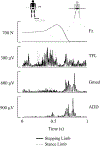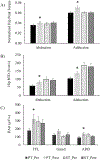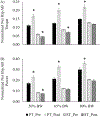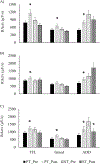Low-dose hip abductor-adductor power training improves neuromechanical weight-transfer control during lateral balance recovery in older adults
- PMID: 30343209
- PMCID: PMC6293473
- DOI: 10.1016/j.clinbiomech.2018.10.018
Low-dose hip abductor-adductor power training improves neuromechanical weight-transfer control during lateral balance recovery in older adults
Abstract
Background: Age-related neuromuscular changes in the hip abductor-adductor muscles lead to reduced performance, especially in the rate of force development and power production. These alterations may impair weight transfer control and lateral balance recovery through protective stepping. This study compared the effects of eight weeks of low-dose hip abductor-adductor power and strength training on the performance of isometric maximal voluntary contractions, and lateral balance recovery at different initial weight-bearing conditions in older individuals.
Methods: Eighteen healthy older adults (71.3 (0.9) years) underwent eight weeks of low-dose hip abductor-adductor exercise training involving either power training (n = 10) or lower velocity strength training (n = 8). Outcomes were assessed for hip abductor-adductor isometric maximal voluntary contractions and lateral waist-pull balance perturbations with three initial stepping limb-load conditions (50%, 65%, or 80% body mass).
Findings: Power training increased isometric maximal voluntary contractions abductor-adductor peak torque (14%-18%, p < 0.05), rate of torque development (31%-39%, p < 0.05) and rate of neuromuscular activation (37%-81%, p < 0.05). During lateral balance recovery, power training increased the incidence of stabilizing single lateral steps at 80% body mass pre-load (by 43%, p < 0.05), reduced step lift-off time by 27 ms at 50% body mass (p < 0.05) and decreased downward momentum of the body center of mass at 80% body mass (32%, p < 0.05). Power training also increased in task hip abductor net joint torque (49%-61%, p < 0.05), power (21%-54%, p < 0.05), and abductor-adductor rate of neuromuscular activation (17%-62%, p < 0.05).
Interpretation: Low-dose hip abductor-adductor power training was more effective than strength training at eliciting improvements in maximal neuromuscular performance and enhanced medio-lateral balance recovery.
Keywords: Hip abductors; Lateral balance; Neuromuscular performance; Power training.
Copyright © 2018 Elsevier Ltd. All rights reserved.
Figures




Similar articles
-
Effects of aging on hip abductor-adductor neuromuscular and mechanical performance during the weight transfer phase of lateral protective stepping.J Biomech. 2019 Jan 3;82:244-250. doi: 10.1016/j.jbiomech.2018.10.040. Epub 2018 Nov 9. J Biomech. 2019. PMID: 30455060 Free PMC article.
-
Kinetic, muscle structure, and neuromuscular determinants of weight transfer phase prior to a lateral choice reaction step in older adults.J Electromyogr Kinesiol. 2020 Dec;55:102484. doi: 10.1016/j.jelekin.2020.102484. Epub 2020 Nov 2. J Electromyogr Kinesiol. 2020. PMID: 33176230 Free PMC article.
-
Role of Hip Abductor Muscle Composition and Torque in Protective Stepping for Lateral Balance Recovery in Older Adults.Arch Phys Med Rehabil. 2017 Jun;98(6):1223-1228. doi: 10.1016/j.apmr.2016.10.009. Epub 2016 Nov 10. Arch Phys Med Rehabil. 2017. PMID: 27840133 Free PMC article.
-
Neuromuscular contributions to the age-related reduction in muscle power: Mechanisms and potential role of high velocity power training.Ageing Res Rev. 2017 May;35:147-154. doi: 10.1016/j.arr.2016.09.003. Epub 2016 Sep 30. Ageing Res Rev. 2017. PMID: 27697547 Review.
-
Comparison of traditional and recent approaches in the promotion of balance and strength in older adults.Sports Med. 2011 May 1;41(5):377-400. doi: 10.2165/11539920-000000000-00000. Sports Med. 2011. PMID: 21510715 Review.
Cited by
-
Which Exercise Interventions Can Most Effectively Improve Reactive Balance in Older Adults? A Systematic Review and Network Meta-Analysis.Front Aging Neurosci. 2022 Jan 18;13:764826. doi: 10.3389/fnagi.2021.764826. eCollection 2021. Front Aging Neurosci. 2022. PMID: 35115917 Free PMC article.
-
Comparison of Lateral Perturbation-Induced Step Training and Hip Muscle Strengthening Exercise on Balance and Falls in Community-Dwelling Older Adults: A Blinded Randomized Controlled Trial.J Gerontol A Biol Sci Med Sci. 2021 Aug 13;76(9):e194-e202. doi: 10.1093/gerona/glab017. J Gerontol A Biol Sci Med Sci. 2021. PMID: 33491052 Free PMC article. Clinical Trial.
-
The effects of stroke on weight transfer before voluntary lateral and forward steps.Front Neurol. 2022 Jul 22;13:891439. doi: 10.3389/fneur.2022.891439. eCollection 2022. Front Neurol. 2022. PMID: 35937060 Free PMC article.
-
Lateral Perturbation-Induced and Voluntary Stepping in Fallers and Nonfallers After Stroke.Phys Ther. 2020 Aug 31;100(9):1557-1567. doi: 10.1093/ptj/pzaa109. Phys Ther. 2020. PMID: 32529236 Free PMC article.
-
Intramuscular Fat Influences Neuromuscular Activation of the Gluteus Medius in Older Adults.Front Physiol. 2020 Dec 10;11:614415. doi: 10.3389/fphys.2020.614415. eCollection 2020. Front Physiol. 2020. PMID: 33362586 Free PMC article.
References
-
- Aagaard P, and Andersen JL. Correlation between contractile strength and myosin heavy chain isoform composition in human skeletal muscle. Med Sci Sports Exerc 30: 1217–1222, 1998. - PubMed
-
- Aagaard P, Simonsen EB, Andersen JL, Magnusson P, and Dyhre-Poulsen P. Increased rate of force development and neural drive of human skeletal muscle following resistance training. J Appl Physiol 93: 1318–1326, 2002. - PubMed
-
- Aagaard P, Suetta C, Caserotti P, Magnusson SP, and Kjaer M. Role of the nervous system in sarcopenia and muscle atrophy with aging: strength training as a countermeasure. Scand J Med Sci Sports 20: 49–64, 2010. - PubMed
Publication types
MeSH terms
Grants and funding
LinkOut - more resources
Full Text Sources

